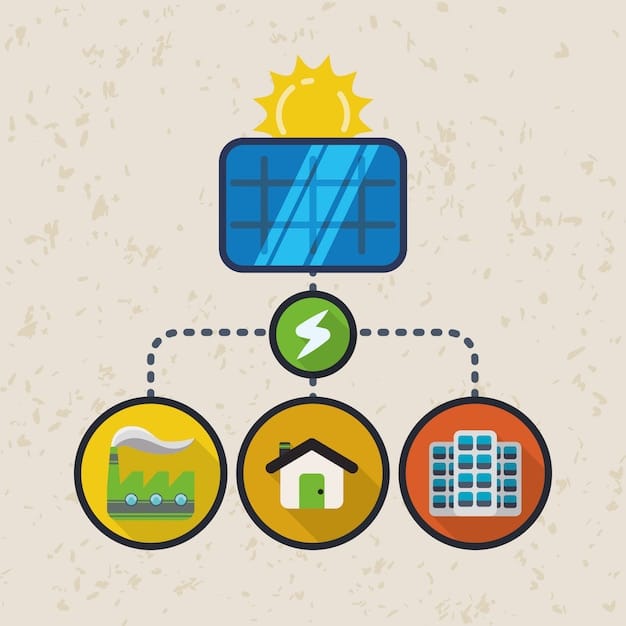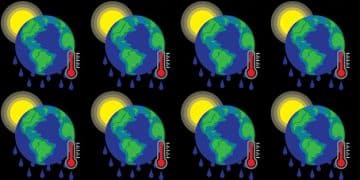Geoengineering: Risks, Benefits, and Ethical Considerations

Geoengineering involves large-scale interventions to counteract climate change, presenting potential benefits like reducing global temperatures but also significant risks such as unpredictable environmental impacts and ethical dilemmas concerning global governance and unintended consequences.
As the effects of climate change become increasingly dire, scientists are exploring radical measures known as geoengineering. Understanding what are the potential risks and benefits of geoengineering? A discussion of the science and ethical considerations is crucial for informed decision-making about our planet’s future.
Understanding Geoengineering: A Broad Overview
Geoengineering, also known as climate engineering, refers to large-scale, intentional interventions in the Earth’s climate system to counteract the adverse effects of global warming. These technologies are often considered as potential supplements to, not replacements for, traditional mitigation strategies like reducing greenhouse gas emissions. Given the urgency of the climate crisis, understanding these approaches is becoming increasingly important.
Geoengineering strategies generally fall into two main categories: solar radiation management (SRM) and carbon dioxide removal (CDR). SRM techniques aim to reflect a small percentage of incoming sunlight back into space, thereby reducing the amount of solar energy absorbed by the Earth. CDR methods, on the other hand, focus on removing carbon dioxide, the primary greenhouse gas, from the atmosphere.
Solar Radiation Management (SRM)
SRM techniques are designed to quickly cool the planet by reflecting sunlight. One of the most discussed SRM methods is stratospheric aerosol injection (SAI), which involves injecting reflective particles, such as sulfate aerosols, into the stratosphere. This approach mimics the cooling effect observed after large volcanic eruptions.
Carbon Dioxide Removal (CDR)
CDR techniques address the root cause of climate change by removing CO2 from the atmosphere. Examples of CDR include afforestation and reforestation, bioenergy with carbon capture and storage (BECCS), direct air capture (DAC), and enhanced weathering. Each of these methods has its own set of challenges and opportunities.
- Stratospheric Aerosol Injection (SAI): Aims to reflect sunlight back into space by injecting aerosols into the stratosphere.
- Direct Air Capture (DAC): Involves capturing CO2 directly from the ambient air using chemical processes.
- Afforestation and Reforestation: Focuses on planting trees to absorb CO2 from the atmosphere through photosynthesis.
- Bioenergy with Carbon Capture and Storage (BECCS): Uses biomass for energy production while capturing and storing the CO2 emissions.
In summary, geoengineering encompasses a range of technologies with the potential to mitigate the effects of climate change. While SRM techniques offer the possibility of rapid cooling, CDR methods aim to address the fundamental issue of excess CO2 in the atmosphere. However, both approaches come with their own set of risks and uncertainties that must be carefully considered.

Potential Benefits of Geoengineering Technologies
Geoengineering technologies are being explored for their potential to address some of the most pressing climate challenges. While these interventions are not without risks, they offer several potential benefits that warrant consideration. These benefits range from reducing global temperatures to mitigating specific regional impacts of climate change.
One of the primary benefits of geoengineering is the potential for rapid cooling of the planet. This is particularly relevant as the world struggles to meet the emission reduction targets set by international agreements. Additionally, some geoengineering techniques could help protect vulnerable ecosystems and populations from the worst effects of climate change.
Rapid Temperature Reduction
Many geoengineering techniques, particularly SRM methods like stratospheric aerosol injection, have the potential to rapidly lower global temperatures. This could provide immediate relief from extreme heat waves, rising sea levels, and other climate-related disasters. The speed at which these technologies could take effect is a major advantage.
Mitigation of Regional Climate Impacts
Certain geoengineering techniques could be tailored to address specific regional climate challenges. For example, marine cloud brightening, which involves spraying seawater into low-lying marine clouds to increase their reflectivity, could be used to protect coral reefs from bleaching caused by rising ocean temperatures.
- Providing immediate relief from extreme weather events such as heat waves.
- Protecting vulnerable ecosystems like coral reefs from irreversible damage.
- Potentially reversing some of the harmful effects of climate change faster than emission reductions alone.
Overall, the potential benefits of geoengineering are significant. The ability to rapidly cool the planet and mitigate regional climate impacts could provide crucial time for societies to transition to sustainable practices and reduce greenhouse gas emissions. However, it is essential to carefully weigh these benefits against the potential risks and ethical concerns associated with these technologies.
Potential Risks and Side Effects
While geoengineering offers potential benefits for mitigating climate change, it also presents significant risks and side effects that must be carefully evaluated. These risks range from environmental impacts to geopolitical and ethical considerations. Understanding these potential downsides is crucial for responsible decision-making about geoengineering.
One of the primary concerns is the potential for unintended environmental consequences. Because geoengineering techniques involve large-scale interventions in the Earth’s climate system, they could disrupt natural weather patterns, harm ecosystems, and affect agricultural productivity. Additionally, the deployment of geoengineering technologies raises complex questions about governance and international cooperation.
Unintended Environmental Consequences
The deployment of geoengineering technologies could have unforeseen and potentially harmful effects on the environment. For example, stratospheric aerosol injection could alter precipitation patterns, leading to droughts in some regions and floods in others.
Geopolitical and Ethical Concerns
Geoengineering also raises important questions about governance, responsibility, and equity. Who decides when and how geoengineering technologies should be deployed? How do we ensure that the benefits and risks are distributed fairly across different countries and communities?
- Altering precipitation patterns and causing droughts or floods in certain regions.
- Potentially harming ecosystems and reducing biodiversity.
- Raising complex questions about governance, responsibility, and equity in the deployment of these technologies.
In conclusion, the potential risks and side effects of geoengineering are substantial and must be carefully considered alongside the potential benefits. A thorough understanding of these risks is essential for making informed decisions about whether and how to pursue geoengineering as a climate mitigation strategy. International cooperation and ethical frameworks are needed to address the governance challenges associated with these technologies.

Ethical Considerations in Geoengineering
The development and potential deployment of geoengineering technologies raise profound ethical questions. These considerations extend beyond the scientific and technical aspects to encompass issues of justice, fairness, and global governance. Ethical frameworks are needed to guide decision-making about geoengineering and ensure that these technologies are used responsibly.
One of the central ethical challenges is the potential for geoengineering to create winners and losers. Because these technologies could have different impacts in different regions, they could exacerbate existing social and economic inequalities. It is also essential to consider the moral hazard that geoengineering could reduce the incentive to mitigate climate change through emission reductions.
Justice and Fairness
Geoengineering could disproportionately benefit some countries or communities while harming others. For example, altering precipitation patterns could reduce agricultural productivity in some regions, leading to food shortages and economic hardship. Ensuring that the benefits and risks are distributed fairly is a critical ethical challenge.
Moral Hazard
The availability of geoengineering technologies could reduce the urgency to address climate change through emission reductions. Politicians and policymakers might be tempted to rely on geoengineering as a quick fix, neglecting the long-term need to transition to a sustainable economy.
- The potential for some countries or communities to benefit disproportionately while others are harmed.
- The risk that geoengineering could reduce the urgency to address climate change through emission reductions.
- The need for transparent and inclusive decision-making processes to ensure that ethical considerations are taken into account.
In summary, ethical considerations are central to the debate about geoengineering. Addressing these ethical challenges requires a commitment to justice, fairness, and global cooperation. Transparent and inclusive decision-making processes are needed to ensure that ethical considerations are taken into account in the development and deployment of geoengineering technologies.
Governance and Regulation of Geoengineering
The governance and regulation of geoengineering technologies pose significant challenges due to their potential global impacts and the lack of established international frameworks. Effective governance is essential to ensure that geoengineering is used responsibly and that its benefits and risks are distributed equitably. This requires international cooperation, transparency, and accountability.
One of the key challenges is the absence of a clear international authority with the power to regulate geoengineering activities. Existing environmental treaties and agreements do not adequately address the unique challenges posed by these technologies. Additionally, there is a need for mechanisms to monitor and assess the environmental and social impacts of geoengineering projects.
International Cooperation
Given the potential for geoengineering to have global impacts, international cooperation is essential to ensure that these technologies are used responsibly. This requires the development of international agreements and protocols that establish norms and standards for geoengineering research and deployment.
Monitoring and Assessment
Effective governance also requires mechanisms to monitor and assess the environmental and social impacts of geoengineering projects. This includes establishing systems for detecting and responding to unintended consequences and ensuring that affected communities have a voice in decision-making processes.
- The need for international agreements and protocols to establish norms and standards for geoengineering research and deployment.
- The importance of transparency and accountability in geoengineering activities.
- The requirement for mechanisms to monitor and assess the environmental and social impacts of geoengineering projects.
In conclusion, the governance and regulation of geoengineering are critical to ensure that these technologies are used responsibly and that their benefits and risks are distributed equitably. International cooperation, transparency, and accountability are essential elements of effective governance. Clear international frameworks are needed to address the unique challenges posed by geoengineering and to ensure that these technologies are used in the best interests of all.
Future Research Directions in Geoengineering
Future research in geoengineering is essential to address the many uncertainties and knowledge gaps surrounding these technologies. This research should focus on improving our understanding of the potential benefits and risks of geoengineering, developing more effective and sustainable techniques, and addressing the ethical and governance challenges associated with these interventions. A multidisciplinary approach is needed, involving scientists, engineers, social scientists, and ethicists.
One of the key priorities is to conduct comprehensive climate modeling studies to assess the potential impacts of different geoengineering scenarios. This includes evaluating the effects on temperature, precipitation, sea level, and ecosystems. Additionally, research is needed to develop more precise and targeted geoengineering techniques that minimize unintended consequences.
Climate Modeling Studies
Comprehensive climate modeling studies are needed to assess the potential impacts of different geoengineering scenarios. These studies should evaluate the effects on temperature, precipitation, sea level, and ecosystems. Advanced models are needed to accurately simulate the complex interactions within the climate system.
Technology Development
Research is needed to develop more effective and sustainable geoengineering techniques. This includes exploring new materials for stratospheric aerosol injection, improving the efficiency of direct air capture technologies, and developing methods for monitoring and mitigating the environmental impacts of geoengineering.
- Conducting comprehensive climate modeling studies to assess the potential impacts of different geoengineering scenarios.
- Developing more effective and sustainable geoengineering techniques.
- Addressing the ethical and governance challenges through interdisciplinary research.
In summary, future research directions in geoengineering are crucial to inform decision-making and ensure that these technologies are used responsibly. Comprehensive climate modeling studies, technology development, and interdisciplinary research are needed to address the many uncertainties and knowledge gaps surrounding geoengineering. This research should be guided by ethical principles and should involve broad engagement with stakeholders to ensure that the benefits and risks are distributed equitably.
| Key Point | Brief Description |
|---|---|
| 🌡️ Temperature Reduction | SRM techniques like SAI can rapidly cool the planet. |
| 🌍 Environmental Risks | Unintended consequences like altered precipitation patterns. |
| ⚖️ Ethical Concerns | Issues of justice, fairness, and global governance. |
| 🌱 CDR Methods | Techniques like afforestation and DAC remove CO2 from the atmosphere. |
Frequently Asked Questions
▼
Geoengineering refers to large-scale interventions designed to counteract the effects of climate change by modifying the Earth’s climate system. These techniques include solar radiation management and carbon dioxide removal.
▼
The two main types are solar radiation management (SRM), which reflects sunlight, and carbon dioxide removal (CDR), which removes CO2 from the atmosphere. Each has unique approaches and challenges.
▼
Risks include unintended environmental consequences like altered precipitation patterns, harm to ecosystems, and ethical concerns about governance and equity. Thorough research and monitoring are essential.
▼
Effective governance requires international cooperation, transparency, and clear international frameworks to ensure responsible use and equitable distribution of benefits and risks. Monitoring is also crucial.
▼
Future research should focus on understanding potential impacts through climate modeling, developing sustainable technologies, and addressing ethical and governance challenges via interdisciplinary studies and stakeholder engagement.
Conclusion
Understanding the potential risks and benefits of geoengineering is crucial for navigating the complex challenges of climate change. While these technologies offer the promise of mitigating some of the worst effects of global warming, they also come with significant uncertainties and ethical considerations that must be carefully addressed. Continued research, international cooperation, and ethical frameworks are essential to ensure that geoengineering is used responsibly and in the best interests of all.





